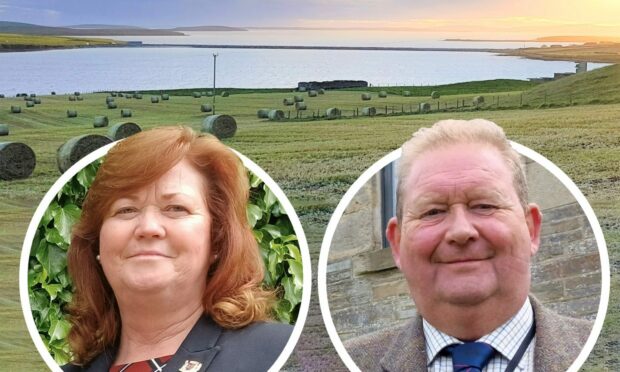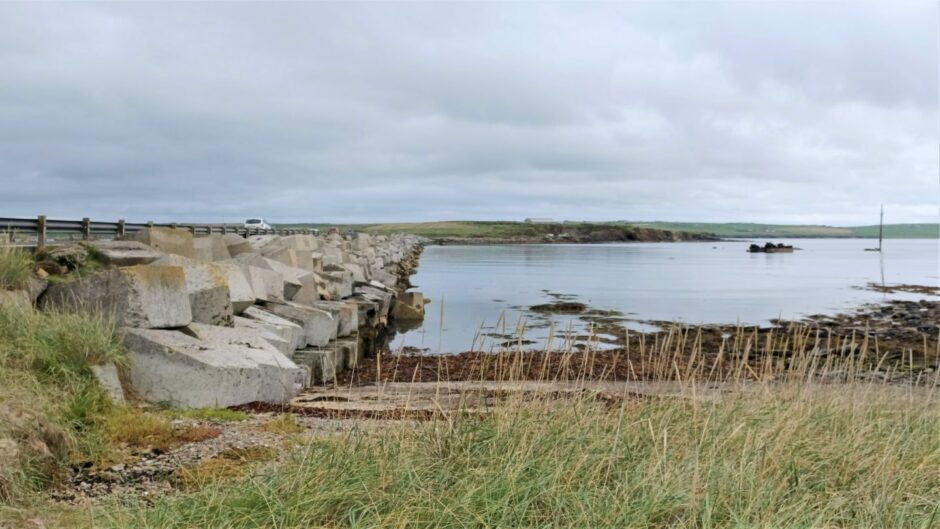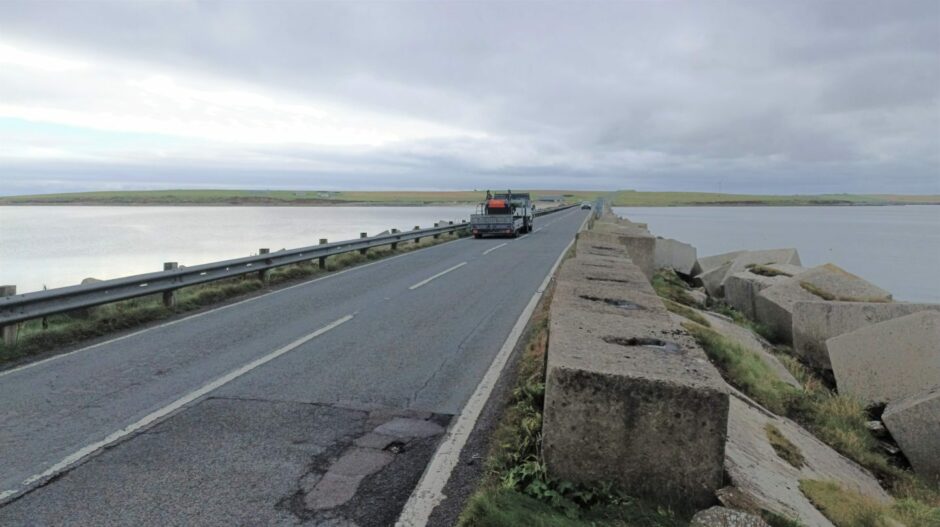Orkney’s four Churchill Barriers may be one of the county’s most iconic sights, but living across the World War 2-era causeways comes with issues.
On the second barrier, which links Lamb Holm and Glimps Holm, it’s not uncommon for waves to crash onto the road during the winter months.
For decades this has been resulting in damage to vehicles and, on occasion, even injury to drivers and passengers.
Bad weather can lead to the barriers being closed for periods, cutting linked isles off from the Orkney mainland.
At barrier number one there may be an even more pressing problem, as suspected subsidence on the roadway could pose another danger to drivers.
However, the cost of solving the problem at the second barrier alone is thought to cost between £40 and £50 million.
Short-term and long-term solutions
This month, the local democracy reporting service sat down with councillors Raymie Peace and Gillian Skuse.
They make up two-thirds of the councillor cohort for the ward which includes the barriers.
Along with their 19 councillor colleagues, they were recently given a presentation by council officers on issues with the barriers.
So, what’s the plan?
Firstly, they said, it’s important to understand the problem and what people actually want to be done.
“There are two major problems at the barriers. Both have to be solved”, said Mr Peace.
“The problem at barrier two is mainly caused by big, big waves from the east.
“Waves from the west are a problem too but not as much because they mainly cause spray.
“Speaking to locals, the overriding opinion is to leave the barrier itself alone, but break the waves before they get to the barrier.
“So, we’re looking at a breakwater of stone or sand.”
However, councillor Peace admits that “in these days of austerity and global crisis”, it’s pretty unlikely that the council are going to find a spare £40 or £50 million.
Councillor Skuse said: “The only way you’re going to fix this is you’re going to go to the Scottish Government to get money to fund it.
“On our own, Orkney council will never be able to afford to fix that.
“It’s the same as the county’s ferries. It’s a massive capital outlay.
“What we have to do is influence nationally, to get the money to support the road infrastructure we have.
“On our own, we don’t have that kind of money. It’s as simple as that.”
Council simply doesn’t have the money to fix problems at barrier two
But the breakwater is the long-term solution, say the councillors. And not every solution needs to be so costly.
They both agree that what could make a huge difference right now, is better communication.
Councillor Skuse said they were told by councillor officers that, between May 2021 and April 2022, the barriers were only closed five times.
The total length of these closures was 23 hours and 50 minutes.
Mrs Skuse said: “When I’ve shared the information about how often there have been closures with people, they’ve been quite shocked.
“For some reason, the perception is that they have been shut more often and for much longer.
“So, we’re giving people information, but maybe it’s too much.
“Maybe letting people know that we’re thinking of closing the barriers is creating the impression that they’re closed more often than they really are.”
The decision to shut the barriers is made jointly by the council, the coastguard and police.
‘We’re giving people information, but maybe it’s too much’
She said, as it stands, the information about barrier closures – and potential closures – seems to be resulting in a skewed public perception.
So, she’s asking council officers to look into how more localised information could be sent out.
Mrs Skuse also said an “impressive” amount of work has been done, looking into issues at the barriers over the past 20 years.
However, she said she isn’t convinced that this information has been communicated to the public.
She said: “It’s really interesting. A couple of years ago, they sent a survey out to everyone who lives in the affected areas.
“They got nearly 400 responses to it. In the replies, 34% of people said they wanted something done to barrier number 2, like building a bridge or something like that.
Many people don’t want any structural change at barrier two
“But, 30% of people said they were really happy with how it is now and didn’t want structural change.
“The next most common ask was for better communication.
“Some people like the fact that living across the barriers feels like living in one of the ferry-linked isles, but it’s not – if that makes sense.”
While better communication may ease the issues are barrier two, there is also the sinking roadway at barrier one.
Part of the problem is no one seems to know how much worse the problem is getting.
Mrs Skuse said: “Obviously we also need to maintain the integrity of the barriers, so people can keep using them.”
The problem of modern vehicles
“There are many more cars on the road and they’re much bigger cars. There are bigger lorries using it.
“Those roads just were not built to withstand that. We have to recognise that.”
With this in mind, Mrs Skuse said the council has appointed Mott MacDonald to visit Orkney and undertake survey work at Churchill barrier one.
This work is due to start next week.
This may sound familiar to anyone in the area, as such work has been undertaken before.
However, Mrs Skuse said the new data gathered by the consultants will be compared to the data gathered previously.
This comparison will help the council “figure out what’s going on.”
Prior to May’s council election, one of councillor Skuse and councillor Peace’s predecessors, Steve Sankey, said he was disappointed by how little progress had been made at the barriers during his four years as a councillor.
So, it will certainly be interesting to see if more progress can be made by the current council.
Councillor Peace said: “Communication is the best short-term fix, but it has to be good communication.
“The breakwater just isn’t going to happen in the immediate future.
“I hope it does happen, but there just isn’t £40million around these days.
“The best we can do at the moment is good communication.”



Conversation